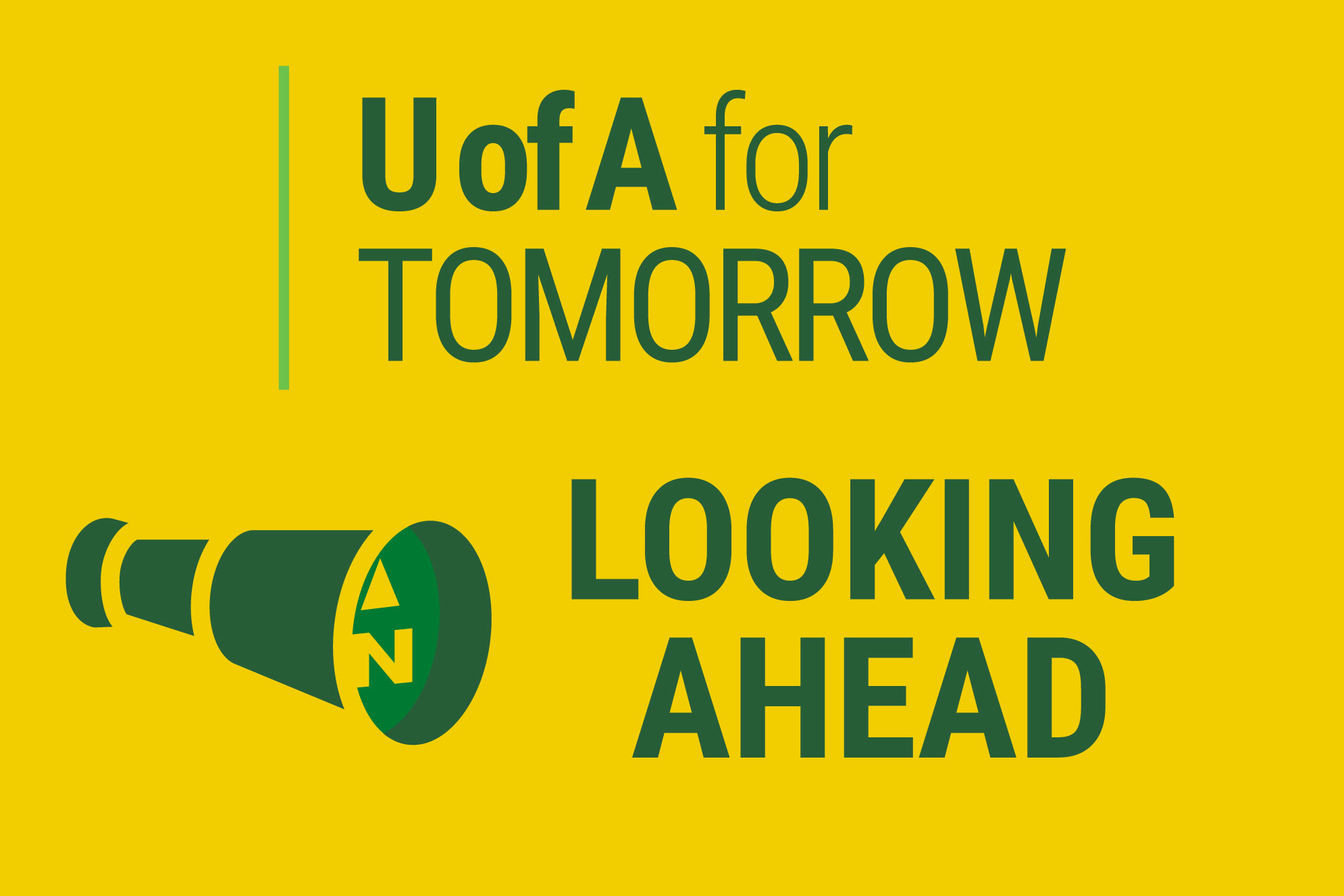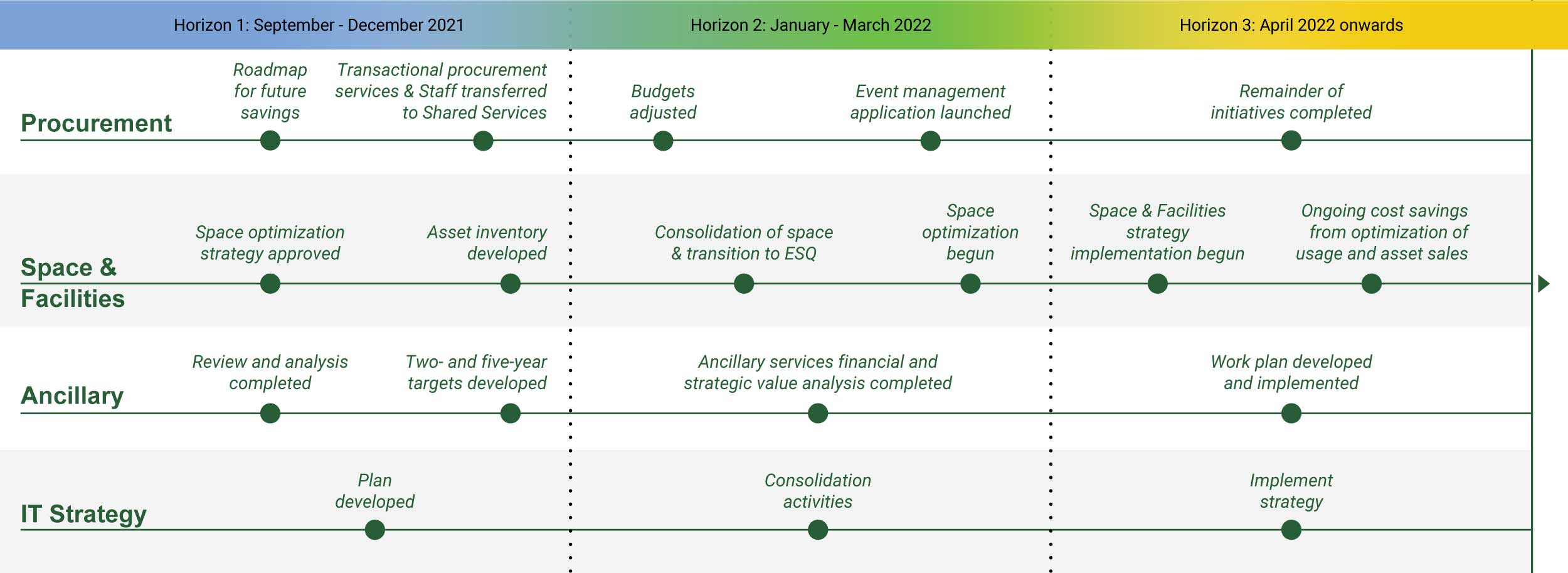Looking ahead at the non-labour streams
Todd Gilchrist - 21 October 2021

This is the third article in the looking ahead series where we look at what to expect with the non-labour streams, such as procurement, space and facilities, and more. Please read part one and part two for information on what's ahead for the administrative workstreams and central support units.
As the university continues to implement the new operating model, every dollar saved through non-labour activities is one less dollar that will need to come from labour savings such as disruptions. These non-labour savings are a key component of responding to the institution's financial situation. To minimize the impact on our labour force, the Service Excellence Transformation (SET) program is leading the development of optimizing non-labour costs to ensure the operating model can be successfully implemented. This article details how the SET program is supporting four non-labour savings initiatives: procurement, space and facilities, and ancillary services, as well as the development of a university-wide IT strategic plan.
Looking ahead
To implement the new operating model, the SET team has been working diligently with staff and faculty from across the university to restructure the university's administrative services and structures. This week, I want to provide you with an overview of the main non-labour initiatives and how they will unfold over the three horizons I've been referring to in my last two updates:
- Horizon 1 - by December 2021
- Horizon 2 - by March 2022 | End of the SET program
- Horizon 3 - April 2022 + | Ongoing operations beyond SET
If you missed my other two articles in this series on the administrative workstreams and central support services, you can find them here.

Here are the major activities and upcoming milestones for each of the non-labour streams.
Procurement
The team working on the procurement stream has identified approximately $17 million in savings to be achieved through 25 initiatives. The majority of these initiatives will be completed in Horizon 3; however, there are a number of key deliverables in Horizon 1 and 2. On October 18, the transfer of procurement transactional processing to the Shared Services unit, including changes to Travel and Expense and Corporate Purchasing Card Reconciliation processes, went live. This was a critical milestone in the university's shift to the operating model to centralize administrative activities, improve efficiencies, and streamline processes from the units into the central operating model.
In Horizon 2, the roadmap for future savings will be finalized and the adjustment of budgets will reflect procurement savings.
Horizon 2 contains a number of other deliverables as well, including the following:
- Review of the results and recommendations arising from the Foundational
- Procurement Task Force (this group is reviewing core policy, processes, and tools and facilitating a two-way interchange with the university community)
- Deployment of university-wide event management software
- Introduction of travel reductions
- Initial review of faculty-managed stores (the Art Store for student supplies is being transferred to the Bookstore; other store reviews include those in Biochemistry, Biological Sciences, Chemistry, ALES, and Facilities & Operations)
In Horizon 3, work outlined in the roadmap will continue and includes the following:
- Continuation of the faculty-managed store reviews
- Review and deployment of university wide storage systems
- Fleet Management review
- Multifunctional device review (e.g. Xerox copiers)
- Lab supplies review
- IT hardware and software review
- Desktop and cellular phone strategy review
Space and Facilities
The University of Alberta has the largest inventory of land and buildings of any research-intensive institution in Canada. Our Integrated Asset Management Strategy guides the management of the university's physical assets, with a focus on the U of A core mission, a reduction of leased space, and appropriate renewal of buildings.
The SET space and facilities initiative is reviewing operational costs associated with all university spaces, facilities, and estates, as well as determining how to better optimize the use of our spaces.
To facilitate this process, two key committees have been formed, the Facilities Optimization Oversight Committee and the Facilities & Space Optimization Implementation Team. Terms of reference for both committees have been finalized and meetings have begun.
Several deliverables are projected for completion in Horizon 1:
- Develop a Space Optimization Strategy for the university
- Finalize the sale of assets, including Husfloen and Ronning House in Camrose, Newton Place, Lot 84 and Ring Houses, and East Campus Village Houses
- Develop an inventory of all lease agreements across the university
- Conclude an initial review of the Vice-President, Facilities & Operations structure as part of administrative restructuring
For completion by Horizon 2, the following activities are planned:
- Achieve the identified budget
- Begin implementing select findings based on the recommendations made by the Facilities Optimization Oversight Committee
- Complete the consolidation of space and transition of staff to Enterprise Square
In Horizon 3, we will begin implementing recommendations approved by the Facilities Optimization Oversight Committee that will result in cost savings (e.g.: exiting from leases, reducing our footprint, etc.). The planning, designing, and other associated costs are not known at this point, although they will be substantial and must be found within existing budgets for both the short-term and long-term initiatives.
Ancillary Services
As part of the Facilities & Operations portfolio, ancillary services include a diverse group of departments and service units that generate sufficient revenue to build operational and capital reserves and deliver strategic business solutions. The following tasks for ancillary services are projected for completion in Horizon 1:
- Conclude a detailed financial and strategic value analysis for Campus Services, including Residence Services, Dining Services, Conference Services, ONEcard, Parking Services, the Campus Bookstore, University Health Centre Pharmacy, the Glen Sather Sports Medicine Clinic, and the Technology Training Centre
- Complete a detailed financial and strategic value analysis for Campus and Community Recreation and the Botanic Gardens within Support and Recreation Services
- Develop a final report with two to five year financial targets for all ancillary services
During Horizon 2, stakeholders will complete a financial and strategic value analysis with recommendations for further actions. In Horizon 3, the team will develop the work plan for implementing the findings from the study.
IT Strategic Plan
An IT strategic plan is in the process of being developed and will support the new operating model as well as the growth strategies as part of the U of A for Tomorrow (UAT) initiative. The critical elements of the strategy for consolidated university IT are:
- Institution-wide: This cannot be just an "IT department" strategy. Digital media and platforms connect the university community;students, instructors, staff, and alumni rely on IT everyday to mediate their activities and interactions.
- Institutional buy-in: For this to be an institutional strategy, it will require broad support from the university community.
- Focused on delivering benefit: Technology itself cannot be the focus; the university's consolidated IT strategy is expected to convey how technologies can deliver tangible and measurable benefits, including actively managing and mitigating cyber risks.
- Agile and flexible: A collaborative approach aligns changing priorities, university needs, and evolving technologies while driving efficient and consistent good practice. Flexibility is required to adapt to differing contexts within colleges and faculties.
- Grounded: The IT strategy is expected to build from university requirements, as well as the quality and usability of our current foundations and technology, and then reach beyond to leverage the future digital possibilities.
- Risk-aware: The university, like all universities, faces a constant barrage of cyber threats. The strategy should integrate cybersecurity as a foundational element in a broader digital and technology plan.
The IT strategic plan will be developed in Horizon 1 and will be implemented in Horizon 3; during Horizon 2, there will be significant focus on completing IT consolidation activities.
Case Study: Finding significant savings on vehicle rentals
As part of SET, the procurement team within the University Services and Finance portfolio has been tasked with finding savings opportunities within the university’s goods and services expenditures.
Working with the university’s preferred rental car provider, the procurement team negotiated and secured better rates and discounts on vehicle rentals and insurance that faculty, staff, and graduate students can take advantage of when booking a vehicle.
With the new agreement, the university will save at least $30,000 per year compared to the previous agreement. Reduced rates are now available for rentals and insurance in both Canada and the United States. In addition, Risk Management recommends that faculty and staff purchase the rental agency's insurance, which provides our biggest savings opportunity.
For Canadian rentals, the university reduced the daily vehicle rental rate by $4 per day. Insurance has been reduced from $24.99 per day to $12 per day. For American rentals, the insurance rate has been reduced from $14.99 USD per day to $6 USD per day. To access these savings and learn more, please refer to the original article here.
Creating a culture of excellence
Core to our new operating model is enhancing the university's service culture and committing to continuous improvement. All administrative functions and activities must service and support the university’s mission to the highest standard with the resources available. There are five core elements that form an effective culture of service excellence: a university-wide shared vision, ownership and accountability for service delivery, clear language around service expectations, formal service standards, and transparency and feedback.
We have have also developed the following service excellence principles for the university which create our service philosophy:
- User-focused, not inward looking.
- Respectful, not commanded.
- Designed with, not for.
- Working together, not in silos.
- Empowered and accountable, not passive.
- Simple and standardized, not over-engineered.
- Continuously improving, not static.
Service culture is often viewed as an input to success, but rather, should be viewed as an output. Working together, we can build and shape our changing culture by defining and demonstrating new behaviours that become embedded and sustained long into the future.
More information
Next week's article, the last in this series, will look ahead to upcoming activities and milestones that have been identified to support and sustain the operating model beyond the SET program. All articles and a timeline chart can also be referenced on the UAT website.
SET will continue to share general changes, including what services are being centralized and the associated timeline, in The Quad email newsletter, on the UAT website, and through other channels such as the stream's specific web pages. We also continue to welcome your questions and other feedback and hope you will join us for an all staff edition of our Ask SET Anything event on November 5.